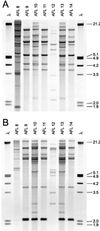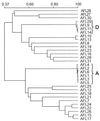Use of a repetitive DNA probe to type clinical and environmental isolates of Aspergillus flavus from a cluster of cutaneous infections in a neonatal intensive care unit
- PMID: 11015372
- PMCID: PMC87445
- DOI: 10.1128/JCM.38.10.3612-3618.2000
Use of a repetitive DNA probe to type clinical and environmental isolates of Aspergillus flavus from a cluster of cutaneous infections in a neonatal intensive care unit
Abstract
Aspergillus flavus is second to A. fumigatus as a cause of invasive aspergillosis, but no standard method exists for molecular typing of strains from human sources. A repetitive DNA sequence cloned from A. flavus and subcloned into a pUC19 vector, pAF28, was used to type 18 isolates from diverse clinical, environmental, and geographic sources. The restriction fragment length polymorphisms generated with EcoRI- or PstI-digested genomic DNA and probed with digoxigenin-labeled pAF28 revealed complete concordance between patterns. Eighteen distinct fingerprints were observed. The probe was used to investigate two cases of cutaneous A. flavus infection in low-birth-weight infants in a neonatal intensive care unit (NICU). Both infants were transported by the same ambulance and crew to the NICU on the same day. A. flavus strains of the same genotype were isolated from both infants, from a roll of tape used to fasten their umbilical catheters, from a canvas bag used to store the tape in the ambulance, and from the tape tray in the ambulance isolette. These cases highlight the need to consider exposures in critically ill neonates that might occur during their transport to the NICU and for stringent infection control practices. The hybridization profiles of strains from a second cluster of invasive A. flavus infections in two pediatric hematology-oncology patients revealed a genotype common to strains from a definite case patient and a health care worker. A probable case patient was infected with a strain with a genotype different from that of the strain from the definite case patient but highly related to that of an environmental isolate. The high degree of discrimination and reproducibility obtained with the pAF28 probe underscores its utility for typing clinical and environmental isolates of A. flavus.
Figures





Similar articles
-
Construction and characterization of a DNA probe for distinguishing strains of Aspergillus flavus.Appl Environ Microbiol. 1995 Mar;61(3):1068-72. doi: 10.1128/aem.61.3.1068-1072.1995. Appl Environ Microbiol. 1995. PMID: 7793909 Free PMC article.
-
Nosocomial transmission of Aspergillus flavus in a neonatal intensive care unit: Long-term persistence in environment and interest of MALDI-ToF mass-spectrometry coupled with convolutional neural network for rapid clone recognition.Med Mycol. 2024 Jan 9;62(1):myad136. doi: 10.1093/mmy/myad136. Med Mycol. 2024. PMID: 38142226
-
A single-source nosocomial outbreak of Aspergillus flavus uncovered by genotyping.Microbiol Spectr. 2024 Aug 6;12(8):e0027324. doi: 10.1128/spectrum.00273-24. Epub 2024 Jun 18. Microbiol Spectr. 2024. PMID: 38888358 Free PMC article.
-
A review molecular typing methods for Aspergillus flavus isolates.Mycopathologia. 2011 Aug;172(2):83-93. doi: 10.1007/s11046-011-9406-x. Epub 2011 Mar 3. Mycopathologia. 2011. PMID: 21369748 Review.
-
Primary cutaneous aspergillosis in neonates: case report and review.Clin Infect Dis. 1996 Jun;22(6):1102-4. doi: 10.1093/clinids/22.6.1102. Clin Infect Dis. 1996. PMID: 8783721 Review.
Cited by
-
Azole-Resistant Aspergillus fumigatus Harboring the TR34/L98H Mutation: First Report in Portugal in Environmental Samples.Microorganisms. 2020 Dec 28;9(1):57. doi: 10.3390/microorganisms9010057. Microorganisms. 2020. PMID: 33379247 Free PMC article.
-
Investigating Clinical Issues by Genotyping of Medically Important Fungi: Why and How?Clin Microbiol Rev. 2017 Jul;30(3):671-707. doi: 10.1128/CMR.00043-16. Clin Microbiol Rev. 2017. PMID: 28490578 Free PMC article. Review.
-
Evaluation of performance of four genotypic methods for studying the genetic epidemiology of Aspergillus fumigatus isolates.J Clin Microbiol. 2002 Aug;40(8):2886-92. doi: 10.1128/JCM.40.8.2886-2892.2002. J Clin Microbiol. 2002. PMID: 12149346 Free PMC article.
-
Guidelines for the Prevention and Treatment of Opportunistic Infections among HIV-exposed and HIV-infected children: recommendations from CDC, the National Institutes of Health, the HIV Medicine Association of the Infectious Diseases Society of America, the Pediatric Infectious Diseases Society, and the American Academy of Pediatrics.MMWR Recomm Rep. 2009 Sep 4;58(RR-11):1-166. MMWR Recomm Rep. 2009. PMID: 19730409 Free PMC article.
-
Simultaneous primary invasive cutaneous aspergillosis in two preterm twins: case report and review of the literature.BMC Infect Dis. 2017 Aug 2;17(1):535. doi: 10.1186/s12879-017-2646-8. BMC Infect Dis. 2017. PMID: 28768499 Free PMC article. Review.
References
-
- Bryce E A, Walker M, Scharf S, Lim A T, Walsh A, Sharp N, Smith J A. An outbreak of cutaneous aspergillosis in a tertiary-care hospital. Infect Control Hosp Epidemiol. 1996;17:70–72. - PubMed
-
- Buffington J, Reporter R, Lasker B A, McNeil M M, Lanson J M, Ross L A, Mascola L, Jarvis W R. Investigation of an epidemic of invasive aspergillosis: utility of molecular typing with the use of random amplified polymorphic DNA probes. Pediatr Infect Dis J. 1994;13:386–393. - PubMed
-
- Challen M P, Moore A J, Martínez-Carrera D. Facile extraction and purification of filamentous fungal DNA. BioTechniques. 1995;18:975–976. - PubMed
Publication types
MeSH terms
Substances
LinkOut - more resources
Full Text Sources
Medical

